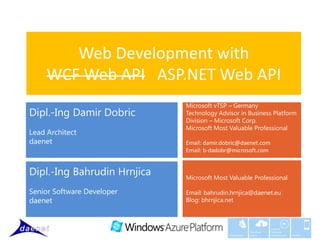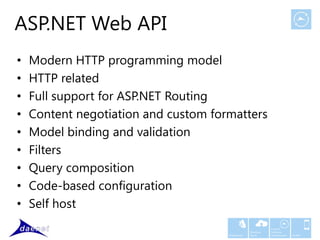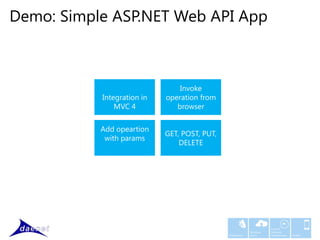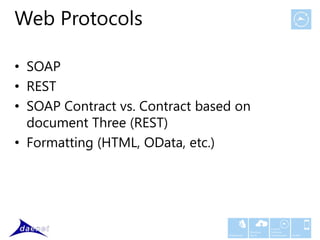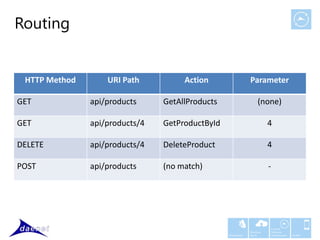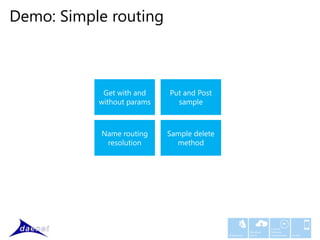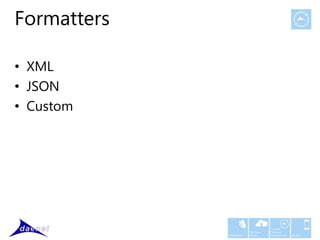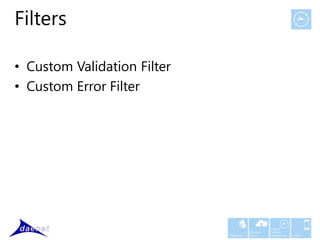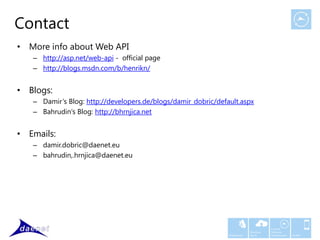Web development with ASP.NET Web API
- 1. Web Development with WCF Web API ASP.NET Web API Microsoft vTSP – Germany Dipl.-Ing Damir Dobric Technology Advisor in Business Platform Division – Microsoft Corp. Microsoft Most Valuable Professional Lead Architect daenet Email: [email protected] Email: [email protected] Dipl.-Ing Bahrudin Hrnjica Microsoft Most Valuable Professional Senior Software Developer Email: [email protected] daenet Blog: bhrnjica.net Custom Windows Software Middleware Azure Development Mobile
- 2. Agenda • From WCF to Asp.NET Web API • Protocols in Web • Routing in Web API • HttpClient – Formatters and Custom Formatters – Filters and Custom Filters • Demos through every subtitles • Recap • Q/A Custom Windows Software Middleware Azure Development Mobile
- 3. ASP.NET Web API Custom Windows Software Middleware Azure Development Mobile
- 4. From WCF to ASP.NET Web API • First apear as WCF Web API • HTTP related • WCF -wider that HTTP (TCP, Named Pipe, WinService, etc) • ASP.NET is closer technology • Can be treated as part of .NET vNext Custom Windows Software Middleware Azure Development Mobile
- 5. ASP.NET Web API • Modern HTTP programming model • HTTP related • Full support for ASP.NET Routing • Content negotiation and custom formatters • Model binding and validation • Filters • Query composition • Code-based configuration • Self host Custom Windows Software Middleware Azure Development Mobile
- 6. Demo: Simple ASP.NET Web API App Invoke Integration in operation from MVC 4 browser Add opeartion GET, POST, PUT, with params DELETE Custom Windows Software Middleware Azure Development Mobile
- 7. Web Protocols • SOAP • REST • SOAP Contract vs. Contract based on document Three (REST) • Formatting (HTML, OData, etc.) Custom Windows Software Middleware Azure Development Mobile
- 8. Routing • Web API uses HTTP methods • MVC-style Routing is still avaliable • Controller handles HTTP requests • Set routing to HttpSelfHostConfiguration Custom Windows Software Middleware Azure Development Mobile
- 9. Routing HTTP Method URI Path Action Parameter GET api/products GetAllProducts (none) GET api/products/4 GetProductById 4 DELETE api/products/4 DeleteProduct 4 POST api/products (no match) - Custom Windows Software Middleware Azure Development Mobile
- 10. Demo: Simple routing Get with and Put and Post without params sample Name routing Sample delete resolution method Custom Windows Software Middleware Azure Development Mobile
- 11. HttpClient Custom Windows Software Middleware Azure Development Mobile
- 12. HttpClient • Modern HttpCLient for .NET • NuGet packages – System.Net.System – System.Net.Http.Formatting – System.Json • Hady when using in JavaScript code Custom Windows Software Middleware Azure Development Mobile
- 13. Formatters • XML • JSON • Custom Custom Windows Software Middleware Azure Development Mobile
- 14. Demo: Using Formatters XML Formatter JSON formatter vCards Custom Formatter vCad Formatter implementation Custom Windows Software Middleware Azure Development Mobile
- 15. Filters • Custom Validation Filter • Custom Error Filter Custom Windows Software Middleware Azure Development Mobile
- 16. Demo: Using Filters Filters sample Custom Filters Custom error Custoim filters validation Custom Windows Software Middleware Azure Development Mobile
- 17. RECAP Custom Windows Software Middleware Azure Development Mobile
- 18. Recap • New way of building REST based web application • Easy of using • Built on top of APS.NET MVC • Routing convention • HTTP Standard method GET, POST, PUT, DELETE • Still support MVC routing methods • Different Formatters: XML, JSON, Custom • Different Filters Custom Windows Software Middleware Azure Development Mobile
- 19. Contact • More info about Web API – http://asp.net/web-api - official page – http://blogs.msdn.com/b/henrikn/ • Blogs: – Damir‘s Blog: http://developers.de/blogs/damir_dobric/default.aspx – Bahrudin‘s Blog: http://bhrnjica.net • Emails: – [email protected] – bahrudin,[email protected] Custom Windows Software Middleware Azure Development Mobile
Editor's Notes
- #3: This should be a recap as this session will dig deeper into the services.
- #5: Slide ObjectiveDescribe security principlesSpeaking notesSimple shared secret securityCan use HTTP or HTTPS to accessUse HTTP for public contentUse HTTPS for secure content (i.e. where using es or Shared Access Signatures)Two 512bit keysKeys used to sign priv requestsTwo keys supports rolling of keysE.g. if one key is compromised can use the second key while first is regeneratedMore on SAS’s soonNotesMore on Security on Day 3http://social.msdn.microsoft.com/Forums/en-US/windowsazure/thread/1e023e8d-0ff9-472e-bcc1-05400a41466c http://blogs.msdn.com/b/usisvde/archive/2010/05/21/best-practices-for-data-storage-security-on-windows-azure.aspx
- #6: Slide ObjectiveDescribe security principlesSpeaking notesSimple shared secret securityCan use HTTP or HTTPS to accessUse HTTP for public contentUse HTTPS for secure content (i.e. where using es or Shared Access Signatures)Two 512bit keysKeys used to sign priv requestsTwo keys supports rolling of keysE.g. if one key is compromised can use the second key while first is regeneratedMore on SAS’s soonNotesMore on Security on Day 3http://social.msdn.microsoft.com/Forums/en-US/windowsazure/thread/1e023e8d-0ff9-472e-bcc1-05400a41466c http://blogs.msdn.com/b/usisvde/archive/2010/05/21/best-practices-for-data-storage-security-on-windows-azure.aspx
- #8: Slide ObjectivesUnderstand the hierarchy of Blob storageSpeaker NotesPut Blob - Creates a new blob or replaces an existing blob within a container.Get Blob - Reads or downloads a blob from the system, including its metadata and properties.Delete Blob - Deletes a blobCopy Blob - Copies a source blob to a destination blob within the same storage account.SnapShot Blob - The Snapshot Blob operation creates a read-only snapshot of a blob.Lease Blob - Establishes an exclusive one-minute write lock on a blob. To write to a locked blob, a client must provide a lease ID.Using the REST API for the Blob service, developers can create a hierarchical namespace similar to a file system. Blob names may encode a hierarchy by using a configurable path separator. For example, the blob names MyGroup/MyBlob1 and MyGroup/MyBlob2 imply a virtual level of organization for blobs. The enumeration operation for blobs supports traversing the virtual hierarchy in a manner similar to that of a file system, so that you can return a set of blobs that are organized beneath a group. For example, you can enumerate all blobs organized under MyGroup/.NotesThe Blob service provides storage for entities, such as binary files and text files. The REST API for the Blob service exposes two resources: containers and blobs. A container is a set of blobs; every blob must belong to a container. The Blob service defines two types of blobs:Block blobs, which are optimized for streaming. This type of blob is the only blob type available with versions prior to 2009-09-19.Page blobs, which are optimized for random read/write operations and which provide the ability to write to a range of bytes in a blob. Page blobs are available only with version 2009-09-19.Containers and blobs support user-defined metadata in the form of name-value pairs specified as headers on a request operation.Using the REST API for the Blob service, developers can create a hierarchical namespace similar to a file system. Blob names may encode a hierarchy by using a configurable path separator. For example, the blob names MyGroup/MyBlob1 and MyGroup/MyBlob2 imply a virtual level of organization for blobs. The enumeration operation for blobs supports traversing the virtual hierarchy in a manner similar to that of a file system, so that you can return a set of blobs that are organized beneath a group. For example, you can enumerate all blobs organized under MyGroup/.A block blob may be created in one of two ways. Block blobs less than or equal to 64 MB in size can be uploaded by calling the Put Blob operation. Block blobs larger than 64 MB must be uploaded as a set of blocks, each of which must be less than or equal to 4 MB in size. A set of successfully uploaded blocks can be assembled in a specified order into a single contiguous blob by calling Put Block List. The maximum size currently supported for a block blob is 200 GB.Page blobs are created and initialized with a maximum size with a call to Put Blob. To write content to a page blob, you call the Put Page operation. The maximum size currently supported for a page blob is 1 TB.Blobs support conditional update operations that may be useful for concurrency control and efficient uploading. Blobs can be read by calling the Get Blob operation. A client may read the entire blob, or an arbitrary range of bytes. For the Blob service API reference, see Blob Service API.
- #9: Slide ObjectivesUnderstand the hierarchy of Blob storageSpeaker NotesPut Blob - Creates a new blob or replaces an existing blob within a container.Get Blob - Reads or downloads a blob from the system, including its metadata and properties.Delete Blob - Deletes a blobCopy Blob - Copies a source blob to a destination blob within the same storage account.SnapShot Blob - The Snapshot Blob operation creates a read-only snapshot of a blob.Lease Blob - Establishes an exclusive one-minute write lock on a blob. To write to a locked blob, a client must provide a lease ID.Using the REST API for the Blob service, developers can create a hierarchical namespace similar to a file system. Blob names may encode a hierarchy by using a configurable path separator. For example, the blob names MyGroup/MyBlob1 and MyGroup/MyBlob2 imply a virtual level of organization for blobs. The enumeration operation for blobs supports traversing the virtual hierarchy in a manner similar to that of a file system, so that you can return a set of blobs that are organized beneath a group. For example, you can enumerate all blobs organized under MyGroup/.NotesThe Blob service provides storage for entities, such as binary files and text files. The REST API for the Blob service exposes two resources: containers and blobs. A container is a set of blobs; every blob must belong to a container. The Blob service defines two types of blobs:Block blobs, which are optimized for streaming. This type of blob is the only blob type available with versions prior to 2009-09-19.Page blobs, which are optimized for random read/write operations and which provide the ability to write to a range of bytes in a blob. Page blobs are available only with version 2009-09-19.Containers and blobs support user-defined metadata in the form of name-value pairs specified as headers on a request operation.Using the REST API for the Blob service, developers can create a hierarchical namespace similar to a file system. Blob names may encode a hierarchy by using a configurable path separator. For example, the blob names MyGroup/MyBlob1 and MyGroup/MyBlob2 imply a virtual level of organization for blobs. The enumeration operation for blobs supports traversing the virtual hierarchy in a manner similar to that of a file system, so that you can return a set of blobs that are organized beneath a group. For example, you can enumerate all blobs organized under MyGroup/.A block blob may be created in one of two ways. Block blobs less than or equal to 64 MB in size can be uploaded by calling the Put Blob operation. Block blobs larger than 64 MB must be uploaded as a set of blocks, each of which must be less than or equal to 4 MB in size. A set of successfully uploaded blocks can be assembled in a specified order into a single contiguous blob by calling Put Block List. The maximum size currently supported for a block blob is 200 GB.Page blobs are created and initialized with a maximum size with a call to Put Blob. To write content to a page blob, you call the Put Page operation. The maximum size currently supported for a page blob is 1 TB.Blobs support conditional update operations that may be useful for concurrency control and efficient uploading. Blobs can be read by calling the Get Blob operation. A client may read the entire blob, or an arbitrary range of bytes. For the Blob service API reference, see Blob Service API.
- #13: Slide ObjectivesUnderstand the hierarchy of Blob storageSpeaker NotesPut Blob - Creates a new blob or replaces an existing blob within a container.Get Blob - Reads or downloads a blob from the system, including its metadata and properties.Delete Blob - Deletes a blobCopy Blob - Copies a source blob to a destination blob within the same storage account.SnapShot Blob - The Snapshot Blob operation creates a read-only snapshot of a blob.Lease Blob - Establishes an exclusive one-minute write lock on a blob. To write to a locked blob, a client must provide a lease ID.Using the REST API for the Blob service, developers can create a hierarchical namespace similar to a file system. Blob names may encode a hierarchy by using a configurable path separator. For example, the blob names MyGroup/MyBlob1 and MyGroup/MyBlob2 imply a virtual level of organization for blobs. The enumeration operation for blobs supports traversing the virtual hierarchy in a manner similar to that of a file system, so that you can return a set of blobs that are organized beneath a group. For example, you can enumerate all blobs organized under MyGroup/.NotesThe Blob service provides storage for entities, such as binary files and text files. The REST API for the Blob service exposes two resources: containers and blobs. A container is a set of blobs; every blob must belong to a container. The Blob service defines two types of blobs:Block blobs, which are optimized for streaming. This type of blob is the only blob type available with versions prior to 2009-09-19.Page blobs, which are optimized for random read/write operations and which provide the ability to write to a range of bytes in a blob. Page blobs are available only with version 2009-09-19.Containers and blobs support user-defined metadata in the form of name-value pairs specified as headers on a request operation.Using the REST API for the Blob service, developers can create a hierarchical namespace similar to a file system. Blob names may encode a hierarchy by using a configurable path separator. For example, the blob names MyGroup/MyBlob1 and MyGroup/MyBlob2 imply a virtual level of organization for blobs. The enumeration operation for blobs supports traversing the virtual hierarchy in a manner similar to that of a file system, so that you can return a set of blobs that are organized beneath a group. For example, you can enumerate all blobs organized under MyGroup/.A block blob may be created in one of two ways. Block blobs less than or equal to 64 MB in size can be uploaded by calling the Put Blob operation. Block blobs larger than 64 MB must be uploaded as a set of blocks, each of which must be less than or equal to 4 MB in size. A set of successfully uploaded blocks can be assembled in a specified order into a single contiguous blob by calling Put Block List. The maximum size currently supported for a block blob is 200 GB.Page blobs are created and initialized with a maximum size with a call to Put Blob. To write content to a page blob, you call the Put Page operation. The maximum size currently supported for a page blob is 1 TB.Blobs support conditional update operations that may be useful for concurrency control and efficient uploading. Blobs can be read by calling the Get Blob operation. A client may read the entire blob, or an arbitrary range of bytes. For the Blob service API reference, see Blob Service API.
- #14: Slide ObjectivesUnderstand the hierarchy of Blob storageSpeaker NotesPut Blob - Creates a new blob or replaces an existing blob within a container.Get Blob - Reads or downloads a blob from the system, including its metadata and properties.Delete Blob - Deletes a blobCopy Blob - Copies a source blob to a destination blob within the same storage account.SnapShot Blob - The Snapshot Blob operation creates a read-only snapshot of a blob.Lease Blob - Establishes an exclusive one-minute write lock on a blob. To write to a locked blob, a client must provide a lease ID.Using the REST API for the Blob service, developers can create a hierarchical namespace similar to a file system. Blob names may encode a hierarchy by using a configurable path separator. For example, the blob names MyGroup/MyBlob1 and MyGroup/MyBlob2 imply a virtual level of organization for blobs. The enumeration operation for blobs supports traversing the virtual hierarchy in a manner similar to that of a file system, so that you can return a set of blobs that are organized beneath a group. For example, you can enumerate all blobs organized under MyGroup/.NotesThe Blob service provides storage for entities, such as binary files and text files. The REST API for the Blob service exposes two resources: containers and blobs. A container is a set of blobs; every blob must belong to a container. The Blob service defines two types of blobs:Block blobs, which are optimized for streaming. This type of blob is the only blob type available with versions prior to 2009-09-19.Page blobs, which are optimized for random read/write operations and which provide the ability to write to a range of bytes in a blob. Page blobs are available only with version 2009-09-19.Containers and blobs support user-defined metadata in the form of name-value pairs specified as headers on a request operation.Using the REST API for the Blob service, developers can create a hierarchical namespace similar to a file system. Blob names may encode a hierarchy by using a configurable path separator. For example, the blob names MyGroup/MyBlob1 and MyGroup/MyBlob2 imply a virtual level of organization for blobs. The enumeration operation for blobs supports traversing the virtual hierarchy in a manner similar to that of a file system, so that you can return a set of blobs that are organized beneath a group. For example, you can enumerate all blobs organized under MyGroup/.A block blob may be created in one of two ways. Block blobs less than or equal to 64 MB in size can be uploaded by calling the Put Blob operation. Block blobs larger than 64 MB must be uploaded as a set of blocks, each of which must be less than or equal to 4 MB in size. A set of successfully uploaded blocks can be assembled in a specified order into a single contiguous blob by calling Put Block List. The maximum size currently supported for a block blob is 200 GB.Page blobs are created and initialized with a maximum size with a call to Put Blob. To write content to a page blob, you call the Put Page operation. The maximum size currently supported for a page blob is 1 TB.Blobs support conditional update operations that may be useful for concurrency control and efficient uploading. Blobs can be read by calling the Get Blob operation. A client may read the entire blob, or an arbitrary range of bytes. For the Blob service API reference, see Blob Service API.
- #16: Slide ObjectivesUnderstand the hierarchy of Blob storageSpeaker NotesPut Blob - Creates a new blob or replaces an existing blob within a container.Get Blob - Reads or downloads a blob from the system, including its metadata and properties.Delete Blob - Deletes a blobCopy Blob - Copies a source blob to a destination blob within the same storage account.SnapShot Blob - The Snapshot Blob operation creates a read-only snapshot of a blob.Lease Blob - Establishes an exclusive one-minute write lock on a blob. To write to a locked blob, a client must provide a lease ID.Using the REST API for the Blob service, developers can create a hierarchical namespace similar to a file system. Blob names may encode a hierarchy by using a configurable path separator. For example, the blob names MyGroup/MyBlob1 and MyGroup/MyBlob2 imply a virtual level of organization for blobs. The enumeration operation for blobs supports traversing the virtual hierarchy in a manner similar to that of a file system, so that you can return a set of blobs that are organized beneath a group. For example, you can enumerate all blobs organized under MyGroup/.NotesThe Blob service provides storage for entities, such as binary files and text files. The REST API for the Blob service exposes two resources: containers and blobs. A container is a set of blobs; every blob must belong to a container. The Blob service defines two types of blobs:Block blobs, which are optimized for streaming. This type of blob is the only blob type available with versions prior to 2009-09-19.Page blobs, which are optimized for random read/write operations and which provide the ability to write to a range of bytes in a blob. Page blobs are available only with version 2009-09-19.Containers and blobs support user-defined metadata in the form of name-value pairs specified as headers on a request operation.Using the REST API for the Blob service, developers can create a hierarchical namespace similar to a file system. Blob names may encode a hierarchy by using a configurable path separator. For example, the blob names MyGroup/MyBlob1 and MyGroup/MyBlob2 imply a virtual level of organization for blobs. The enumeration operation for blobs supports traversing the virtual hierarchy in a manner similar to that of a file system, so that you can return a set of blobs that are organized beneath a group. For example, you can enumerate all blobs organized under MyGroup/.A block blob may be created in one of two ways. Block blobs less than or equal to 64 MB in size can be uploaded by calling the Put Blob operation. Block blobs larger than 64 MB must be uploaded as a set of blocks, each of which must be less than or equal to 4 MB in size. A set of successfully uploaded blocks can be assembled in a specified order into a single contiguous blob by calling Put Block List. The maximum size currently supported for a block blob is 200 GB.Page blobs are created and initialized with a maximum size with a call to Put Blob. To write content to a page blob, you call the Put Page operation. The maximum size currently supported for a page blob is 1 TB.Blobs support conditional update operations that may be useful for concurrency control and efficient uploading. Blobs can be read by calling the Get Blob operation. A client may read the entire blob, or an arbitrary range of bytes. For the Blob service API reference, see Blob Service API.

